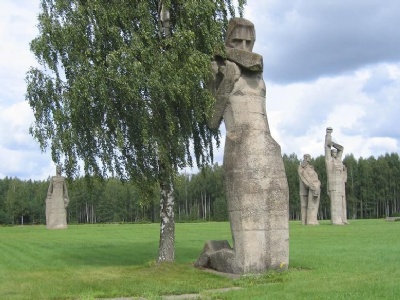Salaspils
This camp is hardly one of the most famous and is located just outside a small town called Salaspils, about twenty kilometres southeast of Riga. It was established in October 1941 on initiative of SS-Sturmbannführer, Rudolf Lange, and was first meant as a major police detention centre. Soviet prisoners of war from Stalag 350 and Jews from the ghetto in Riga were used as slave workers to build the camp. In 1942, bigger plans were made and it was planned to become a collection camp for Jews deported from Germany. But these plans were scrapped and by the end of 1942 the vast majority of prisoners were political prisoners brought to Salaspils from various prisons in Riga. The actual function of the camp partly returned to the original purpose as a police detention centre, but it also functioned as a labour camp. The camp also served as a transit camp for prisoners in one direction or another. Members of the notorious Sonderkommando Arajs probably served in the camp. The camp was liquidated and liberated in the summer of 1944. About 12,000 people went through the camp during its existence, how many died varies depending on the source.
Current status: Demolished with museum (2007).
Location: 56° 52'26" N 24° 18'6" E
Get there: Car.
Follow up in books: Ezergailis, Andrew: The Holocaust in Latvia, 1941-1944 (1996).




The main monument itself is a large long oblique hollow monolith that you can walk inside and listen to the sound of a heart. In the former camp area there are six oversized sculptures that represent sacrifice, resistance and suffering. The whole area is characterized by a wonderful and fascinating classic ugly Soviet concrete architecture in decay, which in a way is a reflection of the society it was built in. Also the town of Salaspils is a typical ”soviet” suburb with dozens of classic socialist residential complexes that despite its gloomy architecture represent the welfare of the socialist worker.